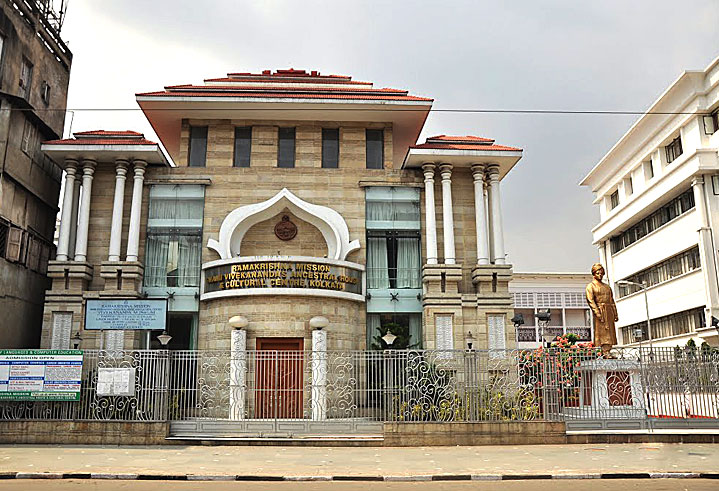

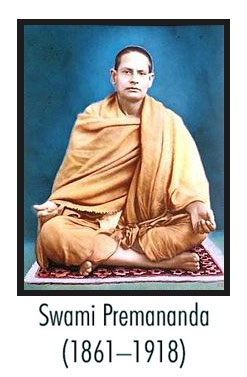 Swami Premananda, a direct Disciple of Sri Ramakrishna had some plans for how the ancestral house of Swami Vivekananda was to be put to use. Writing on this Swami Omkareswarananda recorded the words of Swami Premananda: “I wish the ancestral house of Swamiji be purchased, and there be established a Shiva temple with a large prayer hall and a library. Daily prayer will be performed there in the name of Sri Thakur and Swamiji. Devotional songs and meditation, readings from the scriptures and lectures be delivered there regularly. I wish a gymnasium be set up there too. Students from schools and colleges who could not come to Belur Math easily however much they wished could come here. An establishment on this line, if set up in Kolkata, will do good for them. The more the teachings and ideals of Swamiji get spread among our educated youths the better will it be for the betterment of the country.”
Swami Premananda, a direct Disciple of Sri Ramakrishna had some plans for how the ancestral house of Swami Vivekananda was to be put to use. Writing on this Swami Omkareswarananda recorded the words of Swami Premananda: “I wish the ancestral house of Swamiji be purchased, and there be established a Shiva temple with a large prayer hall and a library. Daily prayer will be performed there in the name of Sri Thakur and Swamiji. Devotional songs and meditation, readings from the scriptures and lectures be delivered there regularly. I wish a gymnasium be set up there too. Students from schools and colleges who could not come to Belur Math easily however much they wished could come here. An establishment on this line, if set up in Kolkata, will do good for them. The more the teachings and ideals of Swamiji get spread among our educated youths the better will it be for the betterment of the country.”
Acquisition Tussle
Although the need for having a suitable memorial at the birthplace of Swami Vivekananda had been keenly felt by the monks and devotees of the Ramakrishna Mission and other admirers of Swamiji for several decades, no concrete steps in that direction could be taken till 1963, the year of Swami Vivekananda’s Birth Centenary. On the eve of the Centenary in 1962, the Government of West Bengal decided to establish a memorial institution in the place where Swamiji was born. The Government enquired whether the Ramakrishna Mission was interested in the matter, and asked them to send a definite proposal. The Centenary Committee prepared a proposal and submitted it to the Government. The Government of West Bengal accepted the proposal and issued notification to acquire the property under the Land Acquisition Act in 1963, and again later in 1973/1974.
By that time the original building had come to a dilapidated condition, and there were 54 families and small business centres as its occupants. These tenants went to the court challenging the acquisition proceedings. The legal tussle went on for three decades.
Finally, in 1993, which was the Centenary Year of Swami Vivekananda’s speeches at the World Parliament of Religions held in Chicago in 1893, Ramakrishna Mission decided to solve the problem through direct negotiations with the tenants. Accordingly, with the consent of the Hon’ble Court, it was settled that Ramakrishna Mission would provide alternative accommodations to the tenants, and the state Government would acquire the whole building and an adjoining plot of land and hand them over to the Ramakrishna Mission.
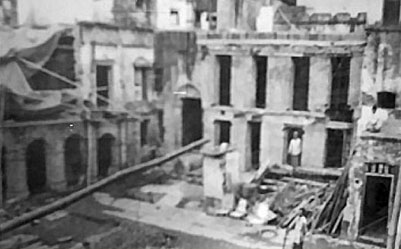 The site of Swamiji’s ancestral house had by then become a virtual slum. To clear up the welter of dilapidated structures, sheds and junk was a Herculean task. First of all, the occupants of the site, 143 families and small trade centres, had to be rehabilitated elsewhere. To begin with, the Ramakrishna Mission bought land from Calcutta Improvement Trust and raised a six-storied building having 28 flats. Since this was not enough, the Ramakrishna Mission authorities purchased many more flats and building from Government and private agencies, and all the tenants were provided alternative accommodation. The whole process cost Rs. 6 crores. When it was completed, the State Government acquired Swamiji’s ancestral house and a few adjacent plots of land, and gave them to the Ramakrishna Mission on 26 May 1999.
The site of Swamiji’s ancestral house had by then become a virtual slum. To clear up the welter of dilapidated structures, sheds and junk was a Herculean task. First of all, the occupants of the site, 143 families and small trade centres, had to be rehabilitated elsewhere. To begin with, the Ramakrishna Mission bought land from Calcutta Improvement Trust and raised a six-storied building having 28 flats. Since this was not enough, the Ramakrishna Mission authorities purchased many more flats and building from Government and private agencies, and all the tenants were provided alternative accommodation. The whole process cost Rs. 6 crores. When it was completed, the State Government acquired Swamiji’s ancestral house and a few adjacent plots of land, and gave them to the Ramakrishna Mission on 26 May 1999.
Apart from the above, the Ramakrishna Mission independently purchased premises on the northern side of Gour Mohan Mukherjee Street to meet the need for a Monks’ Quarters, the proposed rural and slum development work, and for car parking. Some more land had to be purchased for housing and underground water tank, an electric meter room, a generator room and an open-air-auditorium called Ramakrishna Mancha.
After the whole area had been cleared up, there began the saga of re-construction work which involved an expenditure of Rs. 14 crores and 5 years of dedicated work. Apart from restoring Swamiji’s Ancestral House, four magnificent buildings had to be newly constructed. In accordance with the original plan submitted to the Government, four institutions started functioning in the whole complex. These are: 1). Vivekananda Museum – the ancestral house of Swamiji consisting of (a) birth place of Swamiji; (b) Vireshwar Shiva Temple; (c) Thakur Dalan – the place of family worship (d) Meditation rooms (e) Other rooms that were used by Swami Vivekananda in his pre-monastic days, his parents, his grandparents, his brothers and sisters and where are preserved some of the articles used by them; (f) central courtyard. 2) Text Book Library and Seminar Hall; 3) Vivekananda Research Centre; and 4) Slum development and Philanthropic Activities Centre.
Restoration
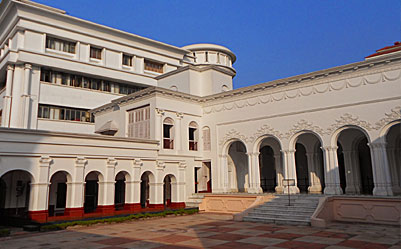 Ramakrishna Mission restored the Ancestral House of Swami Vivekananda without changing any of its original architectural features. This feat of skilled workmanship was accomplished with the technical assistance of the Archaeological Survey of India and the Development Consultants Pvt. Ltd. It should be mentioned here that for this restoration work the same or similar materials as used in the original 18thcentury construction have been used. The restored ancestral house was thenceforth called the Heritage Building.
Ramakrishna Mission restored the Ancestral House of Swami Vivekananda without changing any of its original architectural features. This feat of skilled workmanship was accomplished with the technical assistance of the Archaeological Survey of India and the Development Consultants Pvt. Ltd. It should be mentioned here that for this restoration work the same or similar materials as used in the original 18thcentury construction have been used. The restored ancestral house was thenceforth called the Heritage Building.
The Central Government, the State Government, many well-wishers, generous donors and kind hearted devotees supported the fund for the noble cause. Sri Buddhadev Bhattacharya, the then Hon’ble Chief Minister of West Bengal, Sri Subrata Mukherjee, the Ex-Mayor of Kolkata, local MPs and MLAs as well as local organisations came forward to offer support and active assistance.
A layout of the complex is given in the attached photograph of the model.
How it all began
.png) After years of persuasion, the Government of West Bengal issued notification to acquire the property. A fresh notification was issued in 1973/1974 to acquire a few adjoining plots.
After years of persuasion, the Government of West Bengal issued notification to acquire the property. A fresh notification was issued in 1973/1974 to acquire a few adjoining plots.
.png) The original property was by then divided into several premises and sold to different owners. These premises were handed over to Ramakrishna Mission by the Government of West Bengal, as and when acquired, between 1995 and 1999.
The original property was by then divided into several premises and sold to different owners. These premises were handed over to Ramakrishna Mission by the Government of West Bengal, as and when acquired, between 1995 and 1999.
.png) Ramakrishna Mission took steps to rehabilitate the 143 families and traders first. It took nearly seven years of intense persuasion to complete the task.
Ramakrishna Mission took steps to rehabilitate the 143 families and traders first. It took nearly seven years of intense persuasion to complete the task.
.png) Then started the actual restoration work of the Heritage Building in June 1999.
Then started the actual restoration work of the Heritage Building in June 1999.
.png) The original plan of the building was traced in the Archive of the High Court of Kolkata. It helped to identify the later addition which had almost concealed the original façade and interior.
The original plan of the building was traced in the Archive of the High Court of Kolkata. It helped to identify the later addition which had almost concealed the original façade and interior.
.png) The aim of Ramakrishna Mission was to carefully restore the house into what it looked like when Swamiji (then Narendranath) and his parents, brothers, sisters and other family members lived in it.
The aim of Ramakrishna Mission was to carefully restore the house into what it looked like when Swamiji (then Narendranath) and his parents, brothers, sisters and other family members lived in it.
.png) A detailed technical study was made to identify the later additions which were then removed carefully to reveal the original building. The Ramakrishna Mission took great care to preserve the original structure.
A detailed technical study was made to identify the later additions which were then removed carefully to reveal the original building. The Ramakrishna Mission took great care to preserve the original structure.
.png) The single most important achievement was restoration of the Thakurdalan. It remained concealed behind the facade of a three-storeyed building that was added to it by the occupants. A brick by brick removal of the added façade helped in locating its existence. Its consolidation and restoration was indeed a miracle in itself.
The single most important achievement was restoration of the Thakurdalan. It remained concealed behind the facade of a three-storeyed building that was added to it by the occupants. A brick by brick removal of the added façade helped in locating its existence. Its consolidation and restoration was indeed a miracle in itself.
.png) The restored birthplace of Swami Vivekananda is now the centre of an Educational and Cultural Complex and the centre of the interest of international visitors.
The restored birthplace of Swami Vivekananda is now the centre of an Educational and Cultural Complex and the centre of the interest of international visitors.
Inauguration
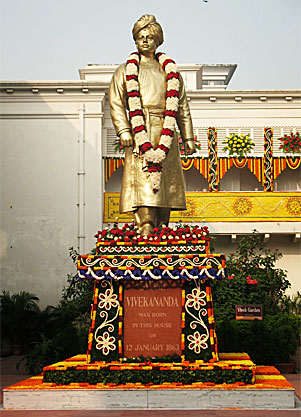 The then Vice-President, Swami Gahananandaji Maharaj, laid the foundation stone of the proposed Ramakrishna Mission Swami Vivekananda Memorial and Cultural Centre on 10 March 2001.
The then Vice-President, Swami Gahananandaji Maharaj, laid the foundation stone of the proposed Ramakrishna Mission Swami Vivekananda Memorial and Cultural Centre on 10 March 2001.
The then General Secretary, Swami Smarananandaji inaugurated the newly built Monks’ Quarters adjacent to the Heritage Building on 17 September 2004
On 26 September 2004, Revered Swami Ranganathanandaji Maharaj, the 13th President of the holy Order, declared open the renovated and restored Ancestral House of Swami Vivekananda and addressed the gathering. Swamis Gahananandaji, Atmasthanandaji, Gitanandaji, Smarananandaji and Prabhanandaji spoke on the occasion. Cultural programmes were organised both in the morning and evening. About 500 monastics and nearly a lakh devotees visited this sacred place to pay homage to Swamiji. Doordarshan telecast the programme live on its Kolkata Channel.
On 1 October 2004, Dr. A P J Abdul kalam, the then President of India, inaugurated the Cultural Complex adjacent to Swamiji’s Ancestral House and addressed the audience. Sri Viren J Shah, the then Governor of West Bengal, Sri Subrata Mukherjee, the then Mayor of Kolkata, and Swami Smarananandaji, General Secretary also spoke on the occasion. A cultural programme was organised in the evening. More than 100 monastics, 1000 devotees and several dignitaries visited this sacred place to pay homage to Swamiji. Doordarshan telecast this programme also live on its National Channel.
Sri T N Chaturvedi, the then Governor of Karnataka, visited the centre on 12 December 2004 and paid homage to Swamiji.
Dr Manmohan Singh, the Prime Minister of India, Sri Pranab Mukherjee, The then Union Defence Minister, Sri Gopalkrishna Gandhi, the then Governor of West Bengal, and Sri Nirupam Sen, Minister of Commerce and Industries, Govt. of West Bengal visited the centre on 12 January 2005 on the occasion of the celebration of the National Youth Day.
Sri Arjun Singh, who was scheduled to formally inaugurate the Vivekananda Research Centre on 4 July 2005, could not come that day owing to ill health. So, Revered Swami Gitanandaji Maharaj, Vice-President of the Order informally inaugurated the Research Centre on the scheduled day. However, Sri Arjun Singh came on 20 July 2005 and formally inaugurated this Research Centre.
Most Revered President Swami Atmasthanandaji Maharaj unveiled the 12.5 ft bronze statue of Swami Vivekananda at this centre on 1 January 2008.
